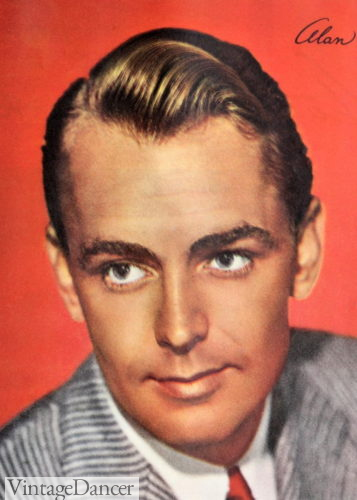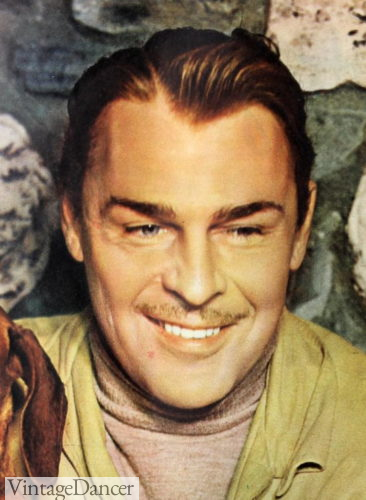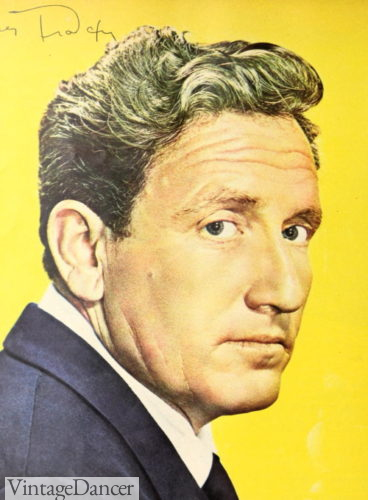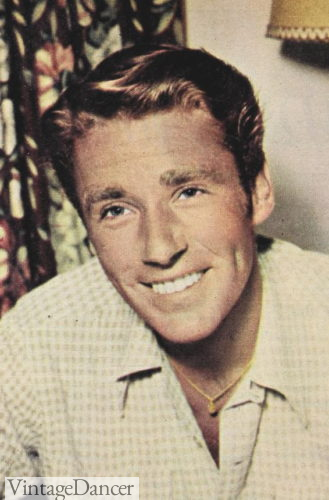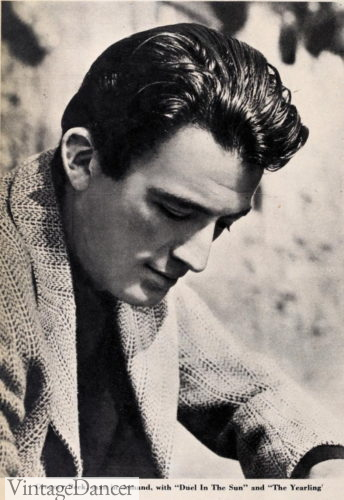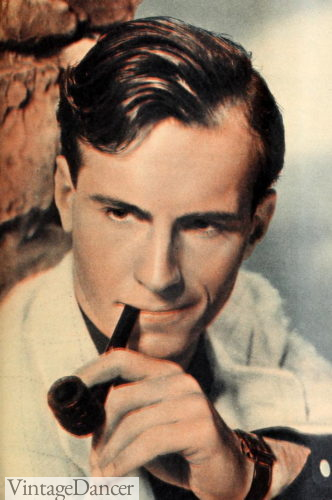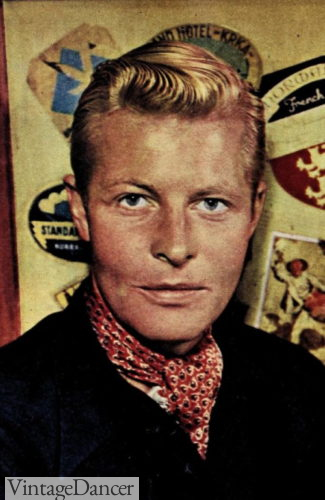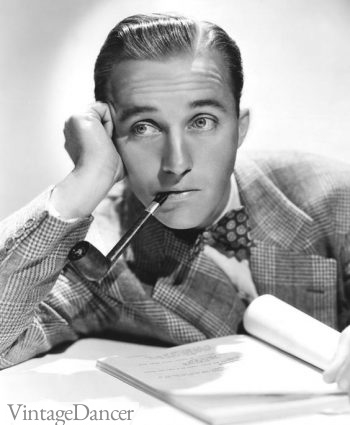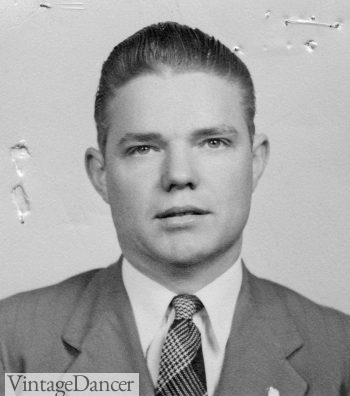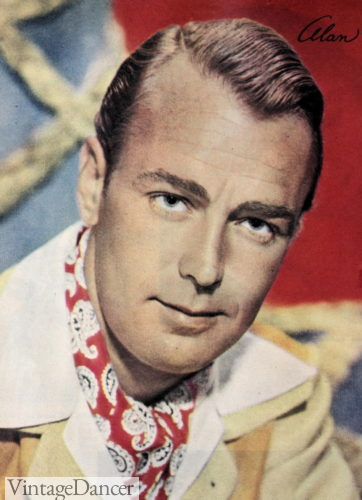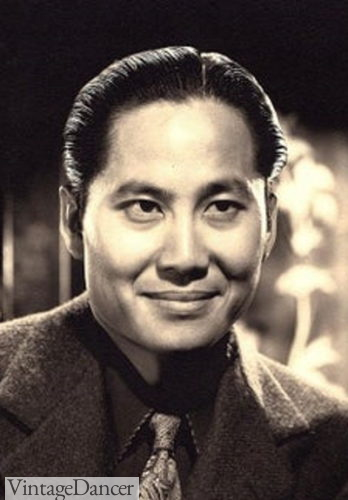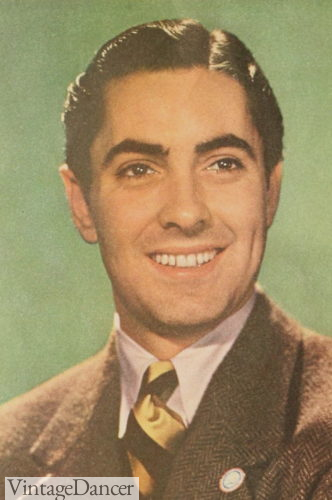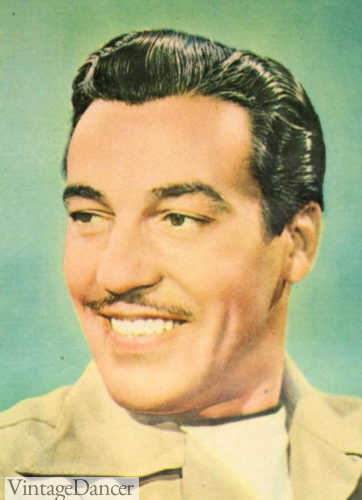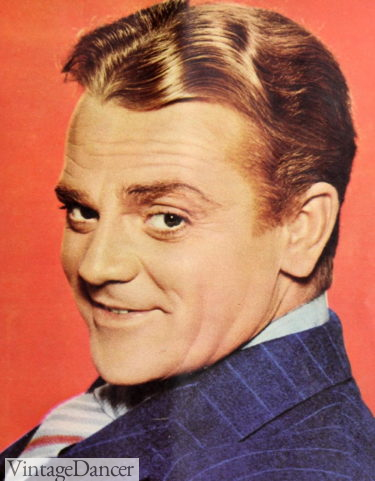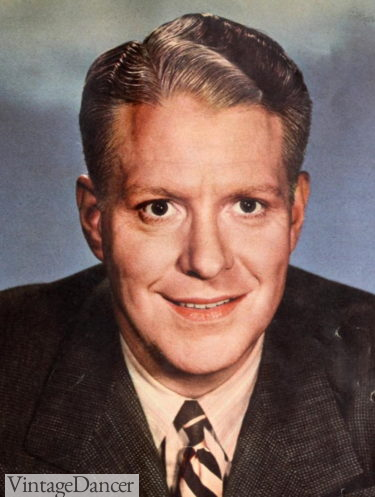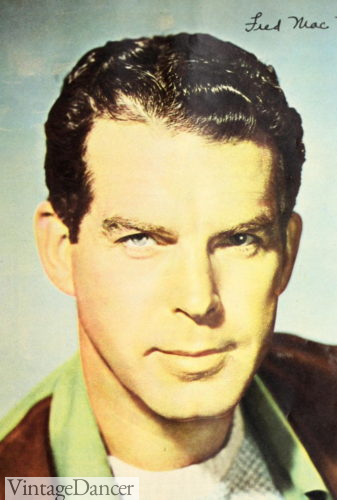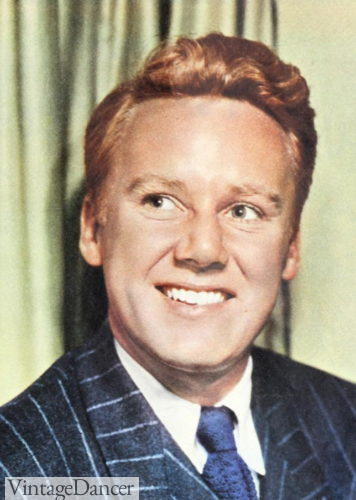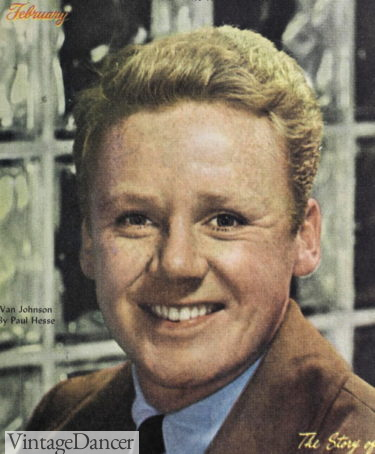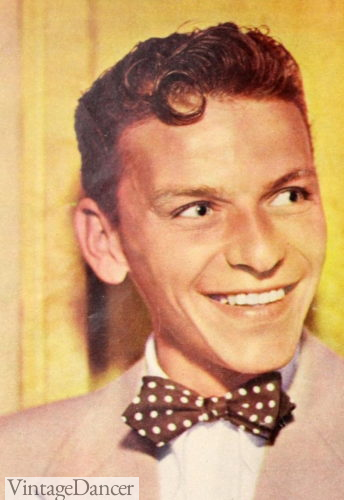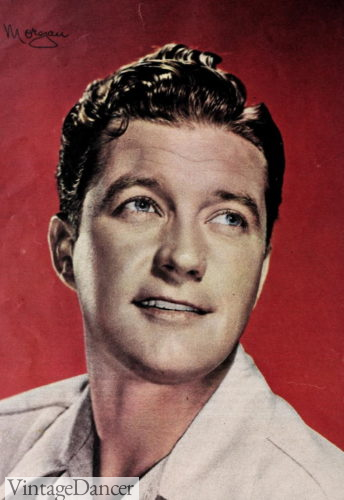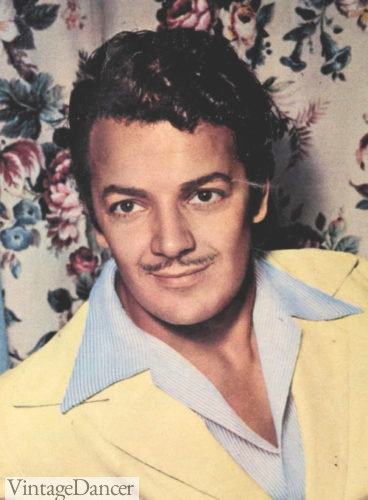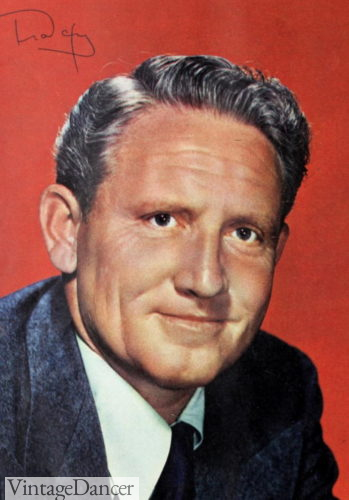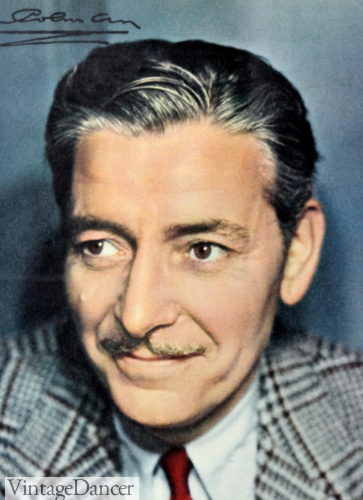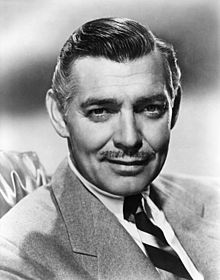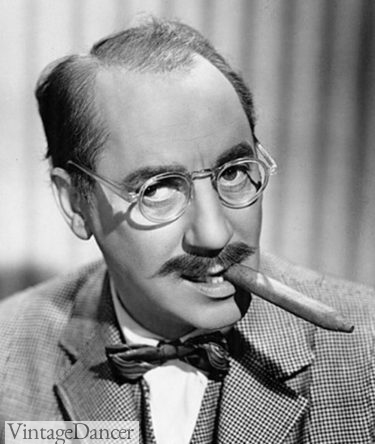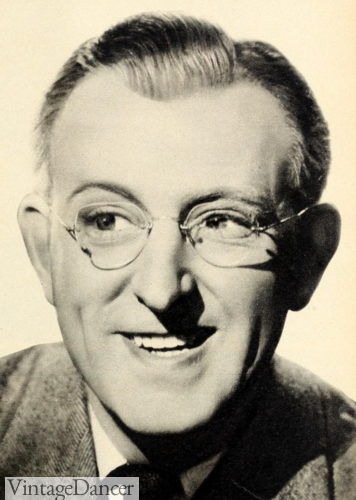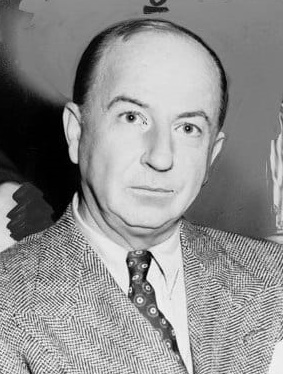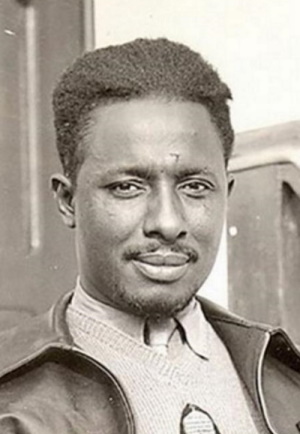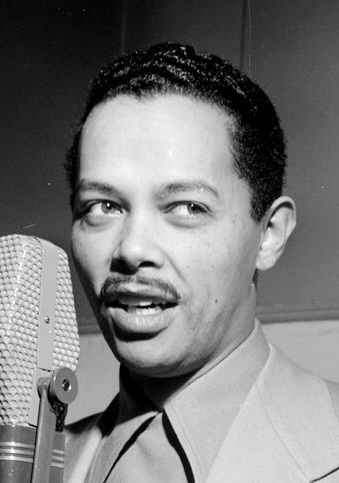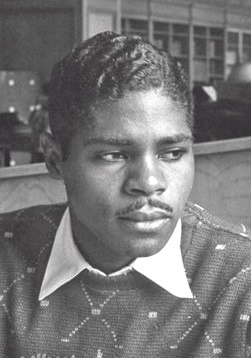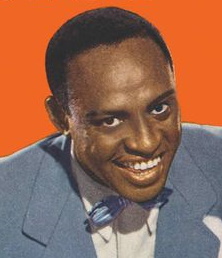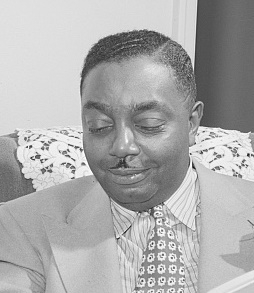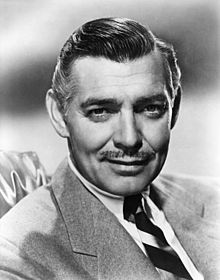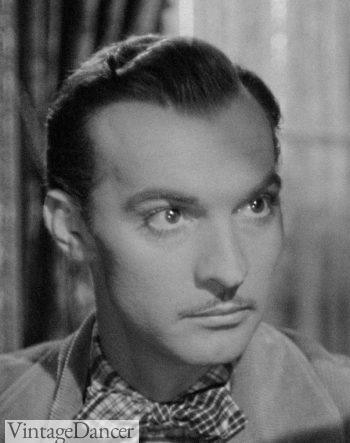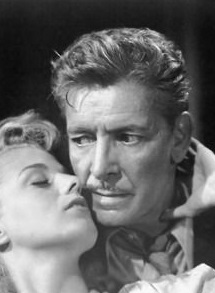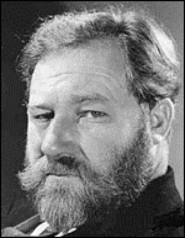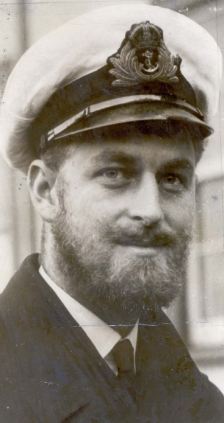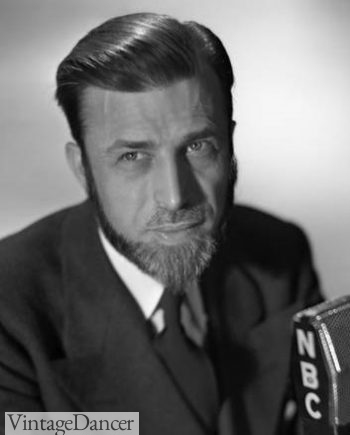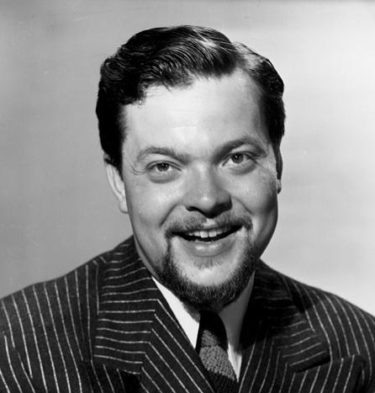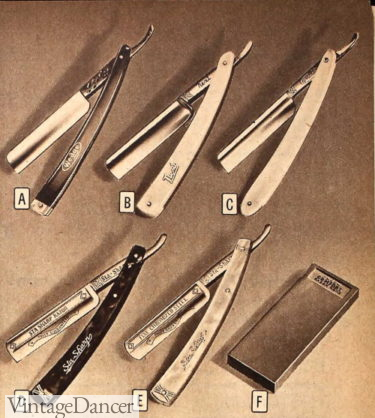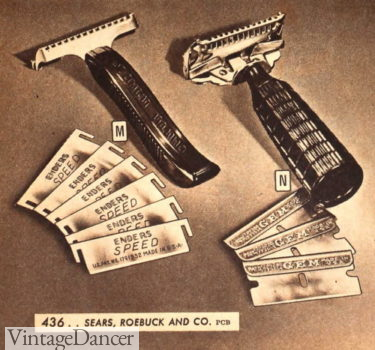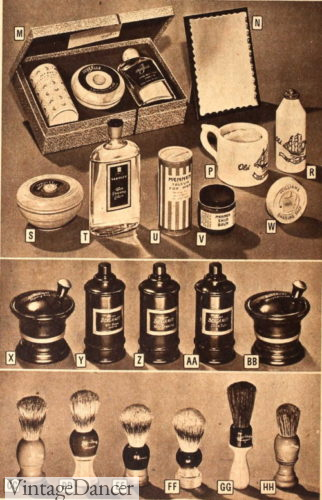The 1940s man had perfectly groomed hair, with frequent visits to the barber. The look is fairly simple to pull off today (unlike those time-consuming women’s styles!). If you want to achieve most men’s 1940s hairstyle you will need to grow your hair long on top but keep it shorter on the sides and back.
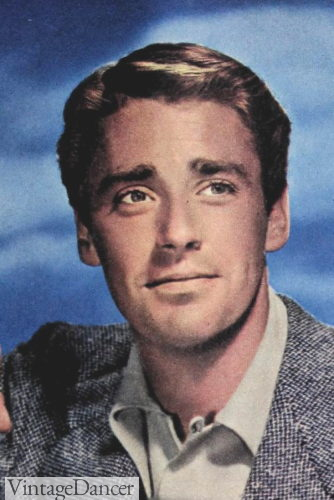
1945 Peter Lawford
Conservative Cuts
Most men had one general hairstyle during the 1940s. Short on the side and back, long on top. The top section could be smoothed back with some pomade or parted on one side and combed over and slightly back to create a wave. Hair was never parted in the center because that was a feminine look.
- 1943 Allen Ladd
- 1943 Brian Donley
- 1943 Spencer Tracy
The difference between early and late 1940s hairstyles was in the amount of wave and height. The early ’40s hair was neatly groomed into a single wave and polished with oil or pomade to give it shine. Hair was usually flat or rounded smooth on top.
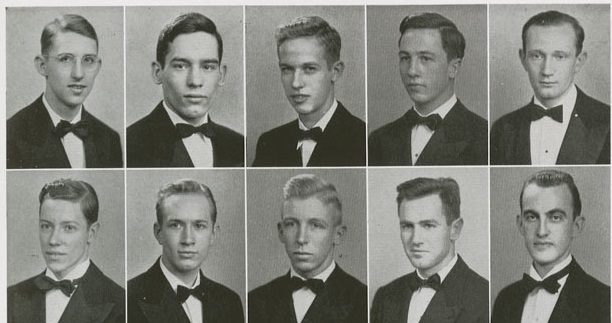
1943 college hairstyles- nicely groomed
Late ’40s men’s hairstyles had more height and more waves. Layers of waves, loose waves, or sculpted waves and curls required only a little product to hold the shape. The very oily look was out of fashion unless the slick-back look was trying to be attained. While the early ’40s were heavily polished, the late ’40s had a freer looseness that still took an effort to style and maintain.
- 1946 Greer Grayson
- 1945 Gregory Peck
- 1943 Helmut Dantine
- 1946 Peter Lawford
Slick Back Hair
Create this look by combing hair oil or pomade through wet hair. You can slick it all back evenly or create a side part with or without a small wave in the front. For straight hair, semi-long on top, trim around sides and back.
Next, use a stiff bristle brush to smooth the hairs down- comb lines should be avoided. Avoid wearing a hat until the oil has a chance to soak in and dry somewhat. You can use a dry cloth to soak up excess oil as well. Oily products are never a good idea for hat wearing, especially vintage hats. It was done in the 1940s, however men also purchased new hats yearly once old ones were trashed by daily use and hair products.
- 1940, parted, slick, flat top
- 1946 slick all back
- 1943 Allen Ladd
- 1946 Alan Ladd
- Keye Luke
- 1941 Tyrone Powder
Waved Hairstyles
To create this look, start off by loading your hair up with the styling cream or liquid and combing it through thoroughly, making a very straight and defined part on one side of your head. The part should be right where the longer top section of hair meets the closer-cut side section.
Next, starting at your hairline in front, comb hair up and to the side, making a little side-swoop on top. Comb the rest of your hair so that it’s brushed back, making sure that it looks even across the entire top of your head. That’s it – the perfect ‘40s hair!
- 1942 Cesar Romero
- 1943 Spencer Tracy
- 1942
- 1942 Nelson Eddy
Curly Hair
Naturally curly hair could be oiled and shaped into side parts, slick back or left un-oiled for a natural frizz. Some younger men let a single curl hang down the forehead, a look that would inspire the Rockabilly styles in the 1950s.
- 1943 Fred Mac Murray
- 1943 Van Johnson
- 1946 Van Johnson (no product)
- 1943 Frank Sinatra
- 1945 Dennis Morgan
- 1945 Cornel Wilde
Greying Hair
Aging men didn’t sacrifice style with grey hair or less hair. Spencer Tracy, Clark Gable and Ronald Colman are excellent examples of a 1940s silver fox.
- 1943 Spencer Tracy
- 1943 Ronald Colman
- Clark Gable
Men were receding hairlines tended to keep hair flat to the head, without oil, but otherwise tried to maintain the look of full hair.
- Groucho Marx
- 1942
- Late 1940s
Ducktail Pompadour
Having a large amount of long hair on top became even more common in the late 1940s, but the trend started in the first few years. It was very popular with the Pachucos of Los Angeles and thus became associated with delinquent youth and eventually motorcycle riding rebels in the 1950s. It was also picked up by singers Elvis Presley and Frank Sinatra.
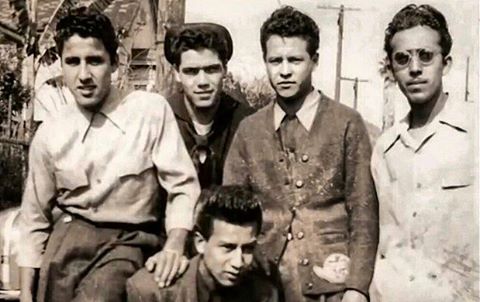
1942 LA Pachocas
The pompadour was full, wavy, and combed up before it swooshed to the back (never dangling down the forehead). The taller the crown the better. While it was usually short in the back, the ducktail style (sometimes called a duck’s ass/D.A.) continued the length down to the neck and tapered to a point, like a duck’s tail.
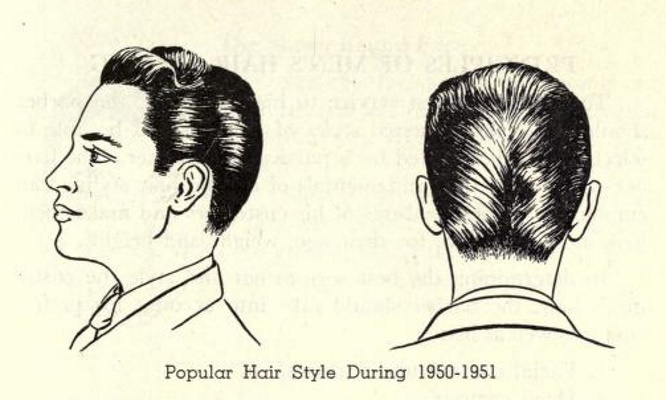
Duck’s back shaping (1951)
African- American Hair
Throughout the 1940s and 1950s the conk (chemical hair straightening with lye) maintained its popularity for black male musicians. Jackie Wilson, Sam Cooke, Jimi Hendrix, Billy Wright, Ike Turner, James Brown, Chuck Berry, Fats Domino, Nat King Cole, Muddy Waters, Miles Davis and Marvin Gaye had a conk during their career. It was however too painful and costly for the average black male to do.
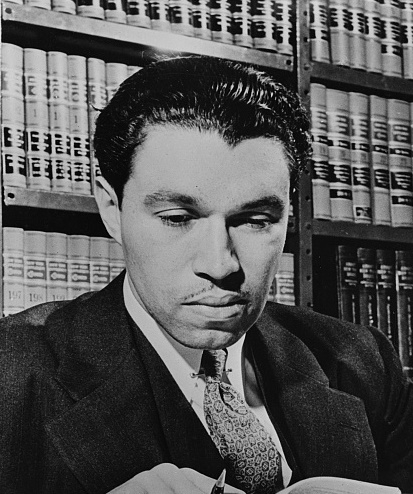
1942 long, straightened, and combed back conk hairstyle
Most hairstyles for African-American men were cut evenly around or slightly, very slightly, longer on top. A part was not common until the end of the decade. Some men did grow out and smooth black hair on the sides and top with hair oil. Urban youth created pompadours by brushing up the front hair as high as they could.
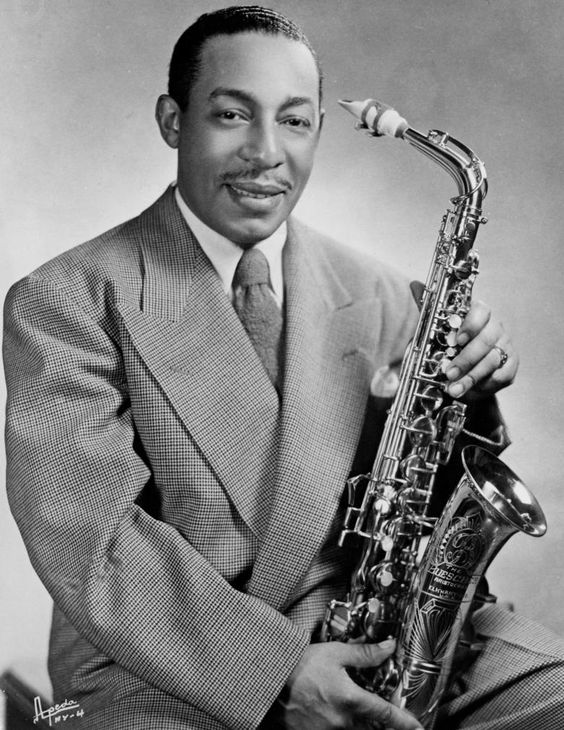
Jazz Musician Johnny Hodges, slicked and oiled short even hair
- Col. John Robinson- long brushed back
- 1946 Billy Eckstine -oil brushed
- 1946 brushed with pomade
- 1949 short, even, natural
Military Cuts
Men in service frequently had to cut hair very short. The ease of these low maintenance styles continued after the war ended. A buzz cut was an even cut all around the head. It was easier to cut with new electric clippers available for home use.
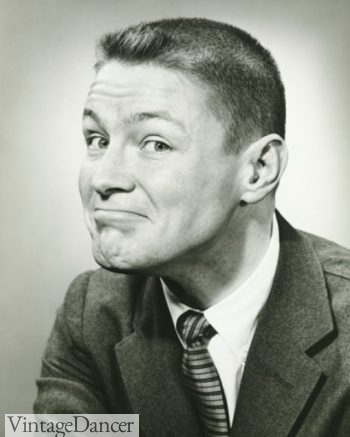
1940s crew cut with slightly taller front
The crew cut or butch cut or brush cut was also achieved with clippers but a little hair was left longer on the top. Some stars had the very front inch or two longer and combed straight up or forward like Jazz musician Gerry Mulligan. Hair could be cut flat on top or rounded such as this:
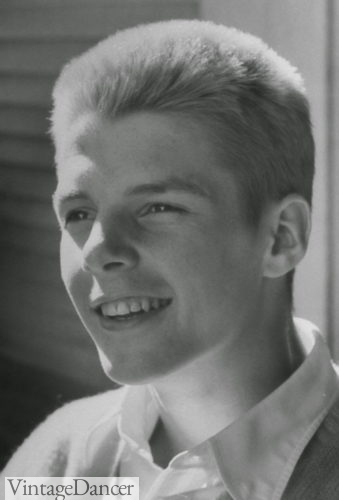
1945 teen with long crew cut
The flat top was clipped all around but left an inch or two longer on top, oiled and combed flat and square.
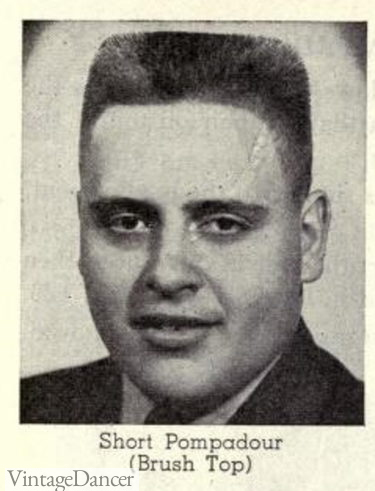
1951 Flat Top (brush top)
The military cuts were not too popular. Most men preferred the fuller wave or slicked styles if they had enough hair tp create them.
This website is useful for WW2 haircuts and how to ask your barber to re-create them.
Facial hair
Most men preferred a clean-shaven look during the 1940s. The few who did wear some facial hair did so with a mustache. The pencil-thin “Errol Flynn” mustache was popular in the 1930s after the actor debuted it on the silver screen. It required shaving the area between the mustache and nose so that the mustache line followed the outline of the upper lip. It was trimmed frequently so that it never became too bushy. A few men continued to wear that style into the 1940s, including leading man Clark Gable. His mustache was not as thin as the ’30s style. It was a little fuller, but still sparse enough to see skin under the hair.
- 1941 small pyramid
- 1940, Clark gable, mustache
- 1945 Zachary Scott mustache
- 1947 Ronald Colman, mustache
In 1947, the handlebar club was formed to support men who chose not to shave their mustaches after service in the military. All styles were allowed, but it was the full bushy mustache with curled long tips that was the group’s namesake.
Older men who could not grow thin mustaches may have turned to a full beard. This was very rare even among older men, but a few actors made it a trademark look whose roles included historical figures, detectives, doctors, and scientists. Beards were also more common with British officers such as the Duke of Edinburgh. Most beards were kept trim and neat.
- James Robertson Justice 1938 in Vice Versa
- Duke of Edinburgh’s beard
- 1944 Robert St. John, beard
- 1939, Orson Welles goatee
Men who adopted the “western” culture were fans of facial hair. The idea was never to look well groomed, but “too busy working the ranch or riding the range” to shave. Beard stubble and mustaches were both seen. Again, this wasn’t part of “fashion” as much as it was a mark of a man’s rustic occupation.
Grooming Tools
Comb and Brush
Prior to the war, most combs were made of tortoiseshell or ivory. Plastic (Lucite) took over after the war (and saved many animals from extinction). Men’s combs came in several tooth widths and sizes. A small comb was often carried in a wallet or pocket. Large combs were used at home along with stiff Bristle brushes. Some brushes had handles but most fit into the palm of the hand (a better grooming experience, in my opinion).

1944 men’s combs, brushes and manicure sets
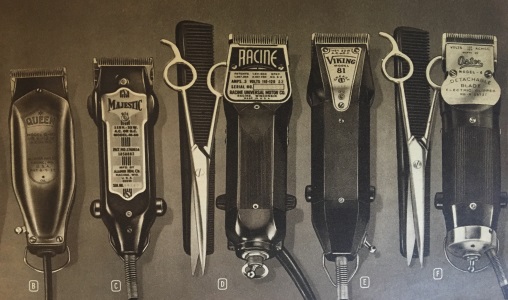
1947 electric hair clippers
Manicure Sets
Neatly trimmed and cleaned nails were not just for women. Men took great care in having a neat appearance which included regular attention to his nails. Clippers, files, cuticle trimmers, and tweezers were kept neat and tidy in a leather pouch.
Hair Tonics, styling products
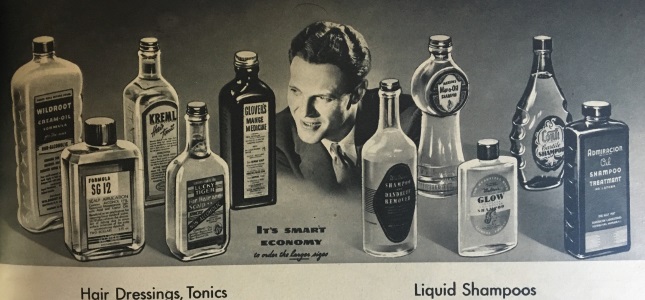
1947 hair tonics and shampoo
There were several types of hair styling tonics for men in the 1940s. Brilliantine cream or Brylcreem was an oily, sticky, Vaseline-like gel that was used for the slick back look. Hair oil added shine without the hold and was used for wave hairstyles. It was often scented with lavender and other light fragrances. Murray’s pomade and Royal Crown pomade were gel-like extra strong hold styling products for sculpted hairstyles that could withstand the rigors of frequent hat removing. They still make many old fashion 1940s hair products today (click the links) for an authentic hair styling experience.
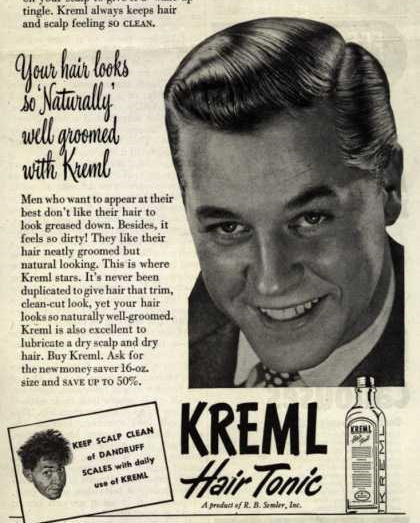
1949 hair creme for slick but soft waves
Shampoo
Hair shampoo was commercially available for those who could afford it. Castile soap, coconut soap, olive oil soaps, and dandruff removing formulas were the primary soaps. While conditioner wasn’t used yet, there were hair tonics and the popular Wildwood Cream that was styled into wet hair, an early type of setting lotion, that was a “non-sticky liquid that leaves hair soft and easy to manage.”
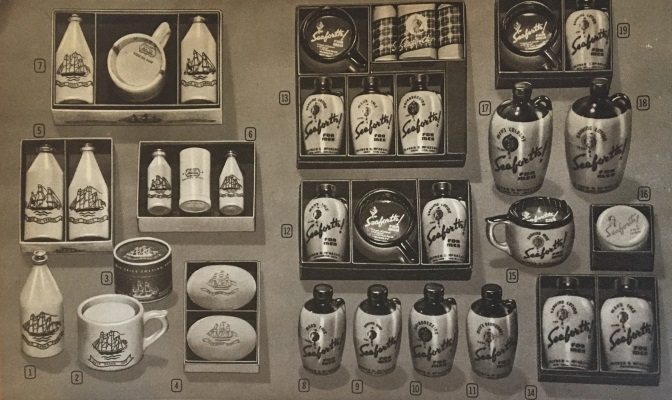
1947 men’s shaving creams, soaps and lotions
Shaving Soaps, Lotions
Shaving was a serious routine for men. Many men still shaved with a straight razor. The safety razor was more popular, however the need for frequent blade changes made them cost prohibitive during most of the 1940s. Electric shavers were also becoming more popular. Aftershave lotion was applied to soothe raw skin. Read about Oscar’s adventures in straight razor shaving here.
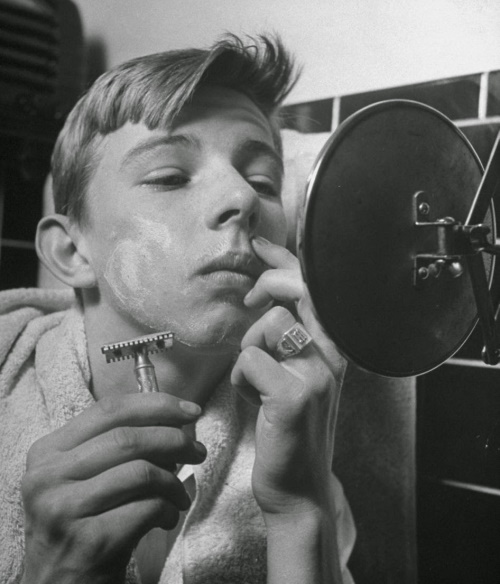
1945 teen shaving with a safety razor
- 1945 Straight Razor
- 1945 Safety Razor
- 1945 shaving cremes and soaps
Deodorant
Powder and roll on tube deodorant were not part of men’s grooming quite yet. Liquid deodorants were either applied to a rag and rubbed in or poured into the palm and splashed on. They were for fragrance, not antiperspirant. Men also used cologne to cover up body smells but these were generally very expensive. All the smells from hair tonic, styling lotions, and after shave products were enough fragrance for most men.
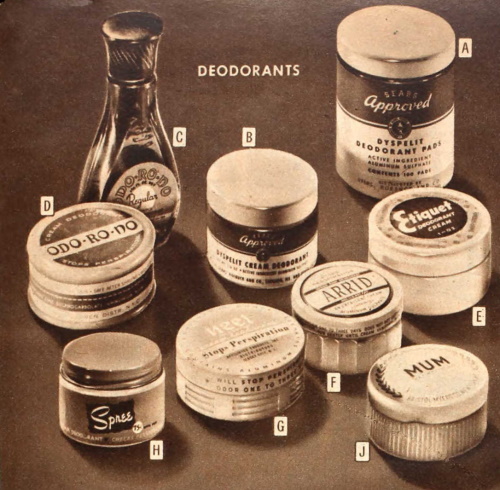
1945 deodorants
More Vintage Men’s Hair History
1920s Men’s Hairstyles and Products History
1930s Men’s Hairstyles and Grooming
1950s Men’s Hairstyles and Grooming
1960s Men’s Hairstyles and Facial Hair
Debbie Sessions has been teaching fashion history and helping people dress for vintage themed events since 2009. She has turned a hobby into VintageDancer.com with hundreds of well researched articles and hand picked links to vintage inspired clothing online. She aims to make dressing accurately (or not) an affordable option for all. Oh, and she dances too.
